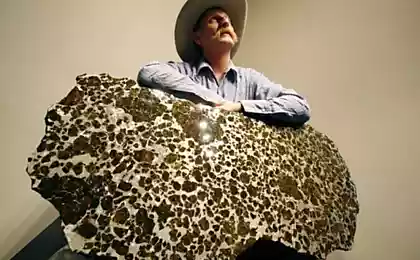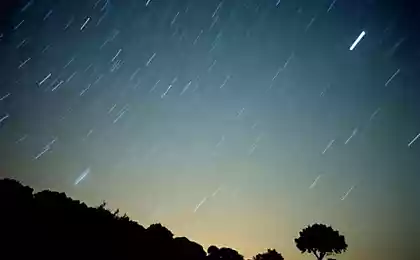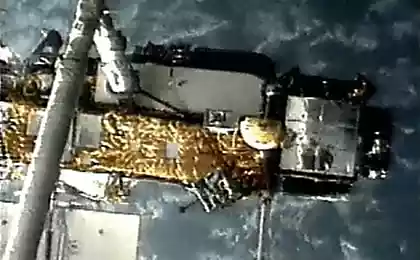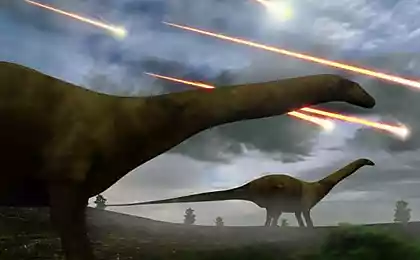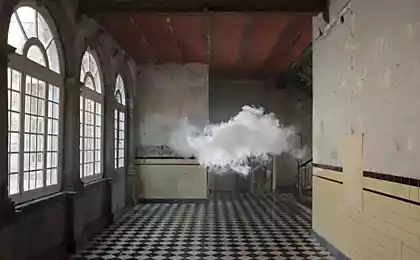660
As fell Tunguska meteorite: all versions
Remember the meteorite. Early on the morning of 30 June 1908 over the taiga near the stony Tunguska river an explosion. According to various estimates, the TNT equivalent of the Tunguska explosion is practically equal to one or two of the bombs exploded over Hiroshima...
Besides Tunguska, an amazing phenomenon known as the Khatanga, Turukhansk and Filimonovo meteorite. After the explosion, was marked magnetic disturbance, which lasted about 5 hours, and during the flight of the Tunguska bolide bright glow was reflected in the Northern rooms of the nearby villages.
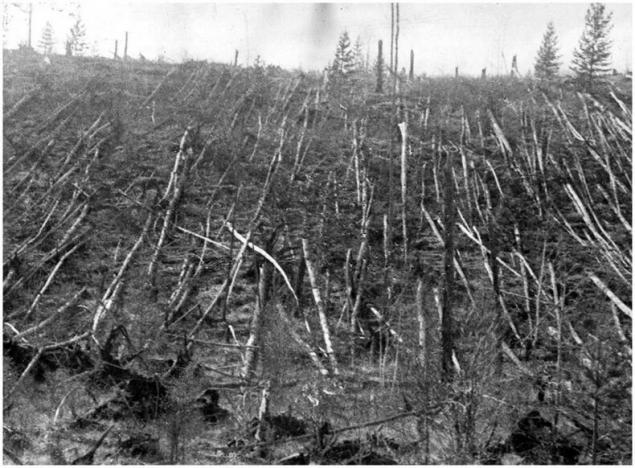
With all the phenomenal incident, a scientific expedition led by L. A. Kulik in place of the "meteorite fall" took place only twenty years later.
What explanation offers this "scientific world"...
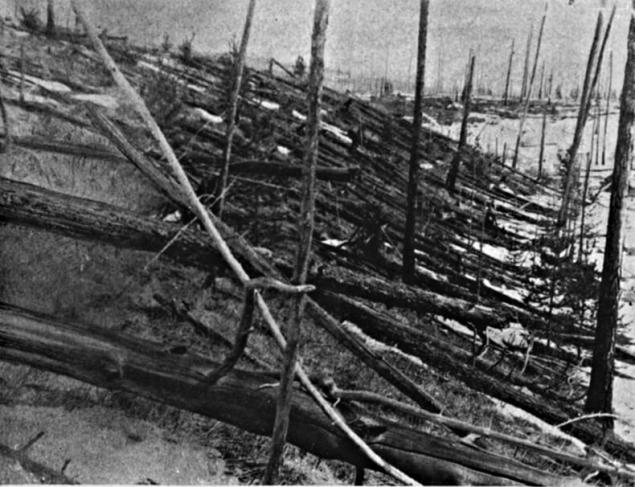
The meteor theory
The first and most mysterious version lasted until 1958, when it was published a refutation. According to this theory, the Tunguska body is a huge iron or stone meteorite.
But now it echoes haunt his contemporaries. Even in 1993, a group of American scientists conducted a study, concluding that the object could be a meteorite exploded at an altitude of about 8 km. is the traces of a meteorite were looking for in the midst of Leonid Alekseevich and a team of scientists, although confused by the initial lack of a crater and tumbled down a fan from the center of the forest.
The most obvious version is one weak spot — numerous expeditions to the crash site of the alleged meteorite did not reveal the debris and remnants of meteorite substance. Moreover, the forest in place of a cosmic catastrophe was tumbled down on a large area, but just at the place where it was supposed to be a meteor crater, the trees remained standing.
Supporters meteor version say — Yes, the whole meteorite no, he completely collapsed, and fell to the Ground numerous small fragments. The problem is that finding these fragments in any serious amount of fails to this day.
Comet
"Comet" version appeared after the meteor. The main difference lies in the nature of the substance that caused the explosion. Comets, unlike meteors, are of loose structure, part of which is ice. As a result, the substance of the comet was rapidly destroyed at the point of entry into the Earth's atmosphere, and the explosion completely finish the job. Therefore, say the supporters version, and fails to detect traces of the substance on the Ground — they just wasn't there.
The comet and meteorite theories exist in various forms, sometimes intertwined with each other. However, no one has been able convincingly to prove their innocence.
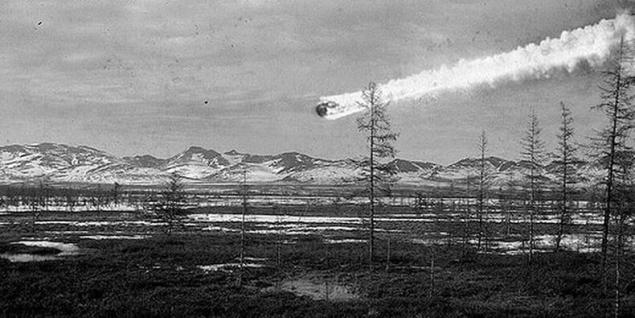
Fantastic theory
Not only the inquisitive minds of scientists is the Tunguska mystery. No less interesting is the theory of the science fiction writer A. P. Kazantsev, who pointed out the similarity between the events of 1908 and the bombing of Hiroshima.
In his original theory Alexander Petrovich suggested that the blame for the crash and explosion of a nuclear reactor interplanetary spacecraft.
When considering the calculations of A. A. Sternfeld, one of the pioneers of Astronautics, 30 June 1908 was created a unique opportunity to fly a drone probe of Mars, Venus and Earth.
The idea was first published in the magazine "Around the world" in 1946. This version expressed by some Western researchers. F. Edwards wrote that in this disaster we lost "from the Universe."
Version Kazantsev received a lively response and found a lot of supporters who have developed and transformed it.
Scientists always extremely skeptical of the "alien" explanation of the incident, but actually in this case the main problem all the same — no real evidence there.
Already in the 1980-ies by Alexander Kazantsev has adjusted its version. In his opinion, the aliens are in distress, took the ship from Earth, and he exploded in space, and the "Tunguska meteorite" was landing, the orbital module.

Nuclear theory
In 1948, American scientist Lincoln La Paz put forward the idea that the "Tunguska phenomenon" is due to the collision of matter with antimatter from space. As you know, annihilation the mutual destruction of matter and antimatter with the release of large amounts of energy. Confirmation of the theory is the presence of radioactive isotopes in wood material with the explosion.
Soviet physicist Boris Konstantinov in the 1960-ies stated even more clearly — in the atmosphere of the Earth is invaded by a comet made of antimatter. That is why the wreckage to find her is simply impossible.
The poor knowledge of the nature and properties of antimatter allows us to consider and a similar version is acceptable, but the majority of scholars towards her skeptically.
In 1965, Nobel prize winners, the American scientists K. Couenne and V. Libby developed the idea of colleagues L. Lapesa antiwestern about the nature of the Tunguska incident.
They suggested that the collision of Earth and a mass of antimatter annihilation has occurred and the release of nuclear energy.
Ural geophysicist A.V. Zolotov analysed the motion of the car, the magnetogram and the nature of the explosion, said that such consequences could lead only to "internal explosion" of personal energy. Despite the arguments of the opponents of the idea, the nuclear theory is still the leader in the number of adherents among experts in the area of the Tunguska problem.
The icy comet

One of the latest is the hypothesis of the icy comet, which was presented by physicist G. Babin. Hypothesis has emerged, based on the diaries of the researcher of the Tunguska problem, Leonid Kulik.
In place of the "fall" past found a substance in the form of ice, covered with peat, but did not pay much attention to it. Babin claims that this compressed ice, was found 20 years later at the scene, not a sign of permafrost, a direct reference to ice comet.
According to the version of the scientist consisting of water and carbon ice comet just scattered on the Ground, coming into contact with it at speed, like an oil pan.
The hypothesis of a rebound of the comet
First formulated by I. S. Astapovich in the article "the failure of the hypothesis of falling to the Ground of the Tunguska meteorite of 30 June 1908" (1963). The author believed that the Tunguska body was a comet, with parameters close to the comet of 1874 (Vinnik-Borelli-Tempel). Entering the atmosphere on a shallow trajectory, the comet for 13 seconds lost all the shell, but the kernel went into space on a hyperbolic trajectory.
In 1984 hypothesis adjusted E. Iordanishvili, in his view, the Tunguska body was a meteorite, not a comet.
Fireball
In 1908 the first researchers of the "Tunguska phenomenon" suggested that the cause of the explosion became a huge fireball.
To this day, the nature of this rare natural phenomenon of ball lightning is not fully understood. Perhaps this explains the fact that the "tie-lightning" version of events has gained popularity among scholars in the 1980-ies.
According to this version, at the crash site exploded in a giant fireball that occurred in the Earth's atmosphere due to the powerful energy pumping ordinary lightning or sharp fluctuations of the atmospheric electric field.
A cloud of cosmic dust
In 1908, the French astronomer Felix de Roy suggested that on June 30 the Earth collided with a cloud of cosmic dust. This version in 1932 he supported the famous academician Vladimir Vernadsky, adding that the movement of cosmic dust through the atmosphere caused a strong development of noctilucent clouds from June 30 to July 2, 1908. Later, in 1961, Tomsk biophysicist and enthusiast of studying the "Tunguska phenomenon" Gennady Plekhanov proposed a more detailed scheme according to which the Earth passed through the interstellar cloud of cosmic dust, one of the largest conglomerates which was what later became known as the "Tunguska meteorite".
The same Gennady Plekhanov put forward a humorous version, which, with some stretch, can be considered as "version 7 bis". Being bitten by mosquitoes during one of the expeditions to the area of the Podkamennaya Tunguska river, he proposed the idea that on 30 June 1908 at this place, gathered a cloud of mosquitoes with a volume of not less than 5 cubic kilometers, resulting volumetric thermal explosion resulting in a fall forest.
To Blame Tesla?
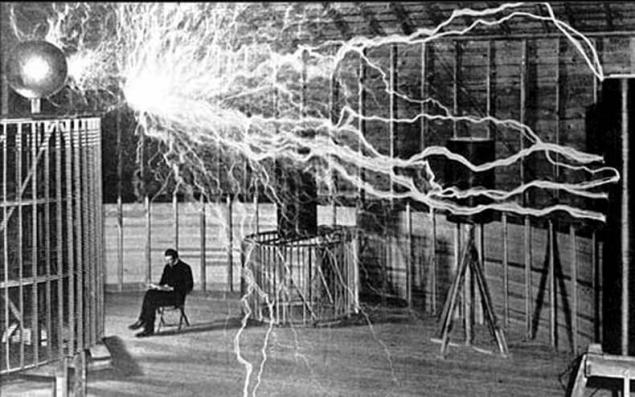
In the beginning of XXI century there was an interesting theory that links Nikola Tesla with the Tunguska event. A few months before the incident, Tesla claimed that could illuminate the road traveler Robert Peary to the North pole. Then he asked for the card "the least inhabited parts of Siberia".
According to this hypothesis, June 30, 1908 Tesla from his laboratory produced "energy servisteel" in the district of Alaska, in order practically to test the capabilities of their equipment. However, the imperfection of technology has led to the fact that Tesla directed energy gone much further and caused massive destruction in the area of Podkamennaya Tunguska.
Learning about the consequences of testing, Tesla chose not to voice his involvement in the incident. The scale of destruction forced Tesla to stop such large-scale experiments.
The weak point of this theory is that any evidence that Nikola Tesla conducted the experiment on 30 June 1908, no. Moreover, the laboratory, which was allegedly made "servisteel", by this time Tesla did not belong to.
Other theories
At the moment there are dozens of different theories, corresponding to different criteria of the incident. Many of them are fantastic and even absurd.
For example, referred to the disintegration of a flying saucer or a departure from the ground of graviola. A. Olkhovatov, a physicist from Moscow, I am absolutely convinced that the event in 1908 – a kind of earth quakes, and the Krasnoyarsk researcher D. Timofeev explained that the reason was the explosion of natural gas, which was set on fire flew into the atmosphere by the meteorite.
American scientists M. Ryan and M. Jackson said that the destruction caused by a collision with a black hole, and physicists V. M. Zhuravlev and Dmitriev believe that the reason the break of the clot of solar plasma and the subsequent explosion of several thousand fireballs.
For more than 100 years from the time of the incident failed to come to a single hypothesis. None of the proposed versions, and are unable to fully comply with all the proven criteria, such as the span of a tall body, a powerful explosion, air wave, burn trees in the midst, atmospheric optical anomalies, magnetic disturbances and the accumulation of isotopes in the soil.
The launch of the spacecraft
Another original version of the "Tunguska phenomenon" is associated with science-fiction writers Arkady and Boris Strugatsky. It was expressed in a humorous form in their novel "Monday begins on Saturday". According to her, 30 June 1908 in the stony Tunguska happened the launch of the spacecraft. Fit it later, that is in July, as it was the ship not just aliens, but aliens kontrastov, that is, natives of the Universe where time moves in the direction opposite ours.
But if Strugatsky brothers version about the alien contraatac was expressed in a humorous vein, in the early 1990-ies of the famous UFO researcher, the leader of the Association "Kosmopoisk" Vadim Chernobrov suggested it as a completely serious explanation "of the Tunguska phenomenon."
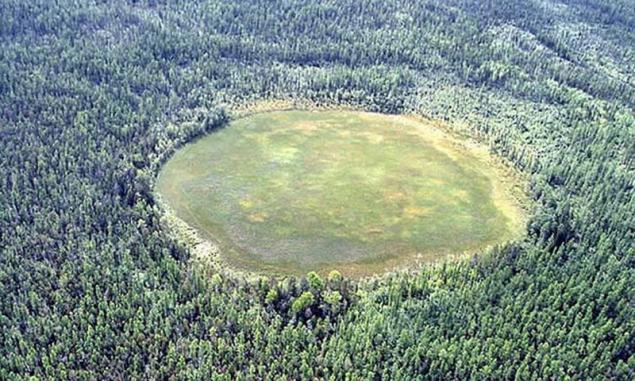
Tectonic forces
In 1991, in "Izvestia an SSSR" A. Y. Olkhovatov printed the first article, the provisions of which were developed in the monographs 1997 and 1999 According to A. Yu. Olkhovatov, the Tunguska explosion was a manifestation of the tectonic energy of the explosive belt of ancient formations — astroblem located near the East Siberian geomagnetic anomaly. Thus, the Tunguska explosion was only a local manifestation of global-scale processes.
Solar plasmoid
In 1984, A. N. Dmitriev (Novosibirsk) jointly with V. K. Zhuravlev published a paper in which he proved the possibility of formation of microtransaction, that is, microscopic plasma, which can be trapped in Earth's magnetic field and drift in his gradient.
Dmitriev and Zhuravlev applied to eyewitness mathematical methods (in 1981 in Tomsk was published a catalogue of eyewitness testimony, including testimony of 720 people), which found that the observers on June 30, 1908 saw two different objects: one was on the East of the trajectory, the second — on the South, and differed sharply and the time of observation. Thus, according to the Novosibirsk researchers, who had two.
The energy corresponding to the explosion of 30 MT, can be accumulated in the ionized plasma formation, with its diameter of about 500 meters, which corresponds to the eyewitness accounts of the huge size of the car.
The trajectory of the plasmoid like ball lightning may change in the process of moving, which explains the inconsistency of data on the direction of movement of the car. Sound and light effects in the motion of the plasmoid is caused by the electromagnetic phenomena that is substantially different from the effects associated with the ballistic wave and removes the contradictions.
The explosion of a plasmoid explains the fire in the forest. Electromagnetic phenomena accompanying the movement and explosion of a plasmoid, obviously, can cause geomagnetic effects, not find a proper explanation within the meteorite version. Plasmodia version explains the futility of attempts to find traces of the meteorite substance on the site of the explosion.
Gas and mud release
The hypothesis put forward in 1981 N. Kudryavtseva and developed in 1986 N. S. Snigirevsky. In the area of Vanavara are manifestations of paleo-volcanism, so the first explosion took place, and then atmospheric phenomena that have been mistaken for a race car.
Interesting findings
Often version was based on the unusual finds made near the study area. In 1993, corresponding member of the Petrovskaya Academy of Sciences and arts, Yu Lubin, consisting of a research expedition of the public Foundation "Tunguska cosmic phenomenon" (he now is its President), was found near Krasnoyarsk unusual stones, and in 1976 in the Republic of Komi have discovered a "velskoe iron", recognized a fragment of a cylinder or sphere of diameter 1.2 m.
Often mentioned and the anomalous zone of "devil's cemetery" with an area of about 250 square meters, located in the Angara taiga kezhemskiy district of the Krasnoyarsk territory.
9 shocking facts about personal hygiene of the Europeans in the eighteenth century
Edible butter age 2 thousand years
On the formed "fallen from heaven" part of dead plants and animals, people prefer to ignore it. The consequences of the June morning of 1908 also include a unique geological object Patom crater located in the Irkutsk region and was discovered in 1949 by geologist V. Kolpakov. Cone height of about 40 meters in diameter on the ridge – about 76 meters. published
P. S. And remember, only by changing their consumption — together we change the world! ©
Source: masterok.livejournal.com/2978441.html
Besides Tunguska, an amazing phenomenon known as the Khatanga, Turukhansk and Filimonovo meteorite. After the explosion, was marked magnetic disturbance, which lasted about 5 hours, and during the flight of the Tunguska bolide bright glow was reflected in the Northern rooms of the nearby villages.

With all the phenomenal incident, a scientific expedition led by L. A. Kulik in place of the "meteorite fall" took place only twenty years later.
What explanation offers this "scientific world"...

The meteor theory
The first and most mysterious version lasted until 1958, when it was published a refutation. According to this theory, the Tunguska body is a huge iron or stone meteorite.
But now it echoes haunt his contemporaries. Even in 1993, a group of American scientists conducted a study, concluding that the object could be a meteorite exploded at an altitude of about 8 km. is the traces of a meteorite were looking for in the midst of Leonid Alekseevich and a team of scientists, although confused by the initial lack of a crater and tumbled down a fan from the center of the forest.
The most obvious version is one weak spot — numerous expeditions to the crash site of the alleged meteorite did not reveal the debris and remnants of meteorite substance. Moreover, the forest in place of a cosmic catastrophe was tumbled down on a large area, but just at the place where it was supposed to be a meteor crater, the trees remained standing.
Supporters meteor version say — Yes, the whole meteorite no, he completely collapsed, and fell to the Ground numerous small fragments. The problem is that finding these fragments in any serious amount of fails to this day.
Comet
"Comet" version appeared after the meteor. The main difference lies in the nature of the substance that caused the explosion. Comets, unlike meteors, are of loose structure, part of which is ice. As a result, the substance of the comet was rapidly destroyed at the point of entry into the Earth's atmosphere, and the explosion completely finish the job. Therefore, say the supporters version, and fails to detect traces of the substance on the Ground — they just wasn't there.
The comet and meteorite theories exist in various forms, sometimes intertwined with each other. However, no one has been able convincingly to prove their innocence.

Fantastic theory
Not only the inquisitive minds of scientists is the Tunguska mystery. No less interesting is the theory of the science fiction writer A. P. Kazantsev, who pointed out the similarity between the events of 1908 and the bombing of Hiroshima.
In his original theory Alexander Petrovich suggested that the blame for the crash and explosion of a nuclear reactor interplanetary spacecraft.
When considering the calculations of A. A. Sternfeld, one of the pioneers of Astronautics, 30 June 1908 was created a unique opportunity to fly a drone probe of Mars, Venus and Earth.
The idea was first published in the magazine "Around the world" in 1946. This version expressed by some Western researchers. F. Edwards wrote that in this disaster we lost "from the Universe."
Version Kazantsev received a lively response and found a lot of supporters who have developed and transformed it.
Scientists always extremely skeptical of the "alien" explanation of the incident, but actually in this case the main problem all the same — no real evidence there.
Already in the 1980-ies by Alexander Kazantsev has adjusted its version. In his opinion, the aliens are in distress, took the ship from Earth, and he exploded in space, and the "Tunguska meteorite" was landing, the orbital module.

Nuclear theory
In 1948, American scientist Lincoln La Paz put forward the idea that the "Tunguska phenomenon" is due to the collision of matter with antimatter from space. As you know, annihilation the mutual destruction of matter and antimatter with the release of large amounts of energy. Confirmation of the theory is the presence of radioactive isotopes in wood material with the explosion.
Soviet physicist Boris Konstantinov in the 1960-ies stated even more clearly — in the atmosphere of the Earth is invaded by a comet made of antimatter. That is why the wreckage to find her is simply impossible.
The poor knowledge of the nature and properties of antimatter allows us to consider and a similar version is acceptable, but the majority of scholars towards her skeptically.
In 1965, Nobel prize winners, the American scientists K. Couenne and V. Libby developed the idea of colleagues L. Lapesa antiwestern about the nature of the Tunguska incident.
They suggested that the collision of Earth and a mass of antimatter annihilation has occurred and the release of nuclear energy.
Ural geophysicist A.V. Zolotov analysed the motion of the car, the magnetogram and the nature of the explosion, said that such consequences could lead only to "internal explosion" of personal energy. Despite the arguments of the opponents of the idea, the nuclear theory is still the leader in the number of adherents among experts in the area of the Tunguska problem.
The icy comet

One of the latest is the hypothesis of the icy comet, which was presented by physicist G. Babin. Hypothesis has emerged, based on the diaries of the researcher of the Tunguska problem, Leonid Kulik.
In place of the "fall" past found a substance in the form of ice, covered with peat, but did not pay much attention to it. Babin claims that this compressed ice, was found 20 years later at the scene, not a sign of permafrost, a direct reference to ice comet.
According to the version of the scientist consisting of water and carbon ice comet just scattered on the Ground, coming into contact with it at speed, like an oil pan.
The hypothesis of a rebound of the comet
First formulated by I. S. Astapovich in the article "the failure of the hypothesis of falling to the Ground of the Tunguska meteorite of 30 June 1908" (1963). The author believed that the Tunguska body was a comet, with parameters close to the comet of 1874 (Vinnik-Borelli-Tempel). Entering the atmosphere on a shallow trajectory, the comet for 13 seconds lost all the shell, but the kernel went into space on a hyperbolic trajectory.
In 1984 hypothesis adjusted E. Iordanishvili, in his view, the Tunguska body was a meteorite, not a comet.
Fireball
In 1908 the first researchers of the "Tunguska phenomenon" suggested that the cause of the explosion became a huge fireball.
To this day, the nature of this rare natural phenomenon of ball lightning is not fully understood. Perhaps this explains the fact that the "tie-lightning" version of events has gained popularity among scholars in the 1980-ies.
According to this version, at the crash site exploded in a giant fireball that occurred in the Earth's atmosphere due to the powerful energy pumping ordinary lightning or sharp fluctuations of the atmospheric electric field.
A cloud of cosmic dust
In 1908, the French astronomer Felix de Roy suggested that on June 30 the Earth collided with a cloud of cosmic dust. This version in 1932 he supported the famous academician Vladimir Vernadsky, adding that the movement of cosmic dust through the atmosphere caused a strong development of noctilucent clouds from June 30 to July 2, 1908. Later, in 1961, Tomsk biophysicist and enthusiast of studying the "Tunguska phenomenon" Gennady Plekhanov proposed a more detailed scheme according to which the Earth passed through the interstellar cloud of cosmic dust, one of the largest conglomerates which was what later became known as the "Tunguska meteorite".
The same Gennady Plekhanov put forward a humorous version, which, with some stretch, can be considered as "version 7 bis". Being bitten by mosquitoes during one of the expeditions to the area of the Podkamennaya Tunguska river, he proposed the idea that on 30 June 1908 at this place, gathered a cloud of mosquitoes with a volume of not less than 5 cubic kilometers, resulting volumetric thermal explosion resulting in a fall forest.
To Blame Tesla?

In the beginning of XXI century there was an interesting theory that links Nikola Tesla with the Tunguska event. A few months before the incident, Tesla claimed that could illuminate the road traveler Robert Peary to the North pole. Then he asked for the card "the least inhabited parts of Siberia".
According to this hypothesis, June 30, 1908 Tesla from his laboratory produced "energy servisteel" in the district of Alaska, in order practically to test the capabilities of their equipment. However, the imperfection of technology has led to the fact that Tesla directed energy gone much further and caused massive destruction in the area of Podkamennaya Tunguska.
Learning about the consequences of testing, Tesla chose not to voice his involvement in the incident. The scale of destruction forced Tesla to stop such large-scale experiments.
The weak point of this theory is that any evidence that Nikola Tesla conducted the experiment on 30 June 1908, no. Moreover, the laboratory, which was allegedly made "servisteel", by this time Tesla did not belong to.
Other theories
At the moment there are dozens of different theories, corresponding to different criteria of the incident. Many of them are fantastic and even absurd.
For example, referred to the disintegration of a flying saucer or a departure from the ground of graviola. A. Olkhovatov, a physicist from Moscow, I am absolutely convinced that the event in 1908 – a kind of earth quakes, and the Krasnoyarsk researcher D. Timofeev explained that the reason was the explosion of natural gas, which was set on fire flew into the atmosphere by the meteorite.
American scientists M. Ryan and M. Jackson said that the destruction caused by a collision with a black hole, and physicists V. M. Zhuravlev and Dmitriev believe that the reason the break of the clot of solar plasma and the subsequent explosion of several thousand fireballs.
For more than 100 years from the time of the incident failed to come to a single hypothesis. None of the proposed versions, and are unable to fully comply with all the proven criteria, such as the span of a tall body, a powerful explosion, air wave, burn trees in the midst, atmospheric optical anomalies, magnetic disturbances and the accumulation of isotopes in the soil.
The launch of the spacecraft
Another original version of the "Tunguska phenomenon" is associated with science-fiction writers Arkady and Boris Strugatsky. It was expressed in a humorous form in their novel "Monday begins on Saturday". According to her, 30 June 1908 in the stony Tunguska happened the launch of the spacecraft. Fit it later, that is in July, as it was the ship not just aliens, but aliens kontrastov, that is, natives of the Universe where time moves in the direction opposite ours.
But if Strugatsky brothers version about the alien contraatac was expressed in a humorous vein, in the early 1990-ies of the famous UFO researcher, the leader of the Association "Kosmopoisk" Vadim Chernobrov suggested it as a completely serious explanation "of the Tunguska phenomenon."

Tectonic forces
In 1991, in "Izvestia an SSSR" A. Y. Olkhovatov printed the first article, the provisions of which were developed in the monographs 1997 and 1999 According to A. Yu. Olkhovatov, the Tunguska explosion was a manifestation of the tectonic energy of the explosive belt of ancient formations — astroblem located near the East Siberian geomagnetic anomaly. Thus, the Tunguska explosion was only a local manifestation of global-scale processes.
Solar plasmoid
In 1984, A. N. Dmitriev (Novosibirsk) jointly with V. K. Zhuravlev published a paper in which he proved the possibility of formation of microtransaction, that is, microscopic plasma, which can be trapped in Earth's magnetic field and drift in his gradient.
Dmitriev and Zhuravlev applied to eyewitness mathematical methods (in 1981 in Tomsk was published a catalogue of eyewitness testimony, including testimony of 720 people), which found that the observers on June 30, 1908 saw two different objects: one was on the East of the trajectory, the second — on the South, and differed sharply and the time of observation. Thus, according to the Novosibirsk researchers, who had two.
The energy corresponding to the explosion of 30 MT, can be accumulated in the ionized plasma formation, with its diameter of about 500 meters, which corresponds to the eyewitness accounts of the huge size of the car.
The trajectory of the plasmoid like ball lightning may change in the process of moving, which explains the inconsistency of data on the direction of movement of the car. Sound and light effects in the motion of the plasmoid is caused by the electromagnetic phenomena that is substantially different from the effects associated with the ballistic wave and removes the contradictions.
The explosion of a plasmoid explains the fire in the forest. Electromagnetic phenomena accompanying the movement and explosion of a plasmoid, obviously, can cause geomagnetic effects, not find a proper explanation within the meteorite version. Plasmodia version explains the futility of attempts to find traces of the meteorite substance on the site of the explosion.
Gas and mud release
The hypothesis put forward in 1981 N. Kudryavtseva and developed in 1986 N. S. Snigirevsky. In the area of Vanavara are manifestations of paleo-volcanism, so the first explosion took place, and then atmospheric phenomena that have been mistaken for a race car.
Interesting findings
Often version was based on the unusual finds made near the study area. In 1993, corresponding member of the Petrovskaya Academy of Sciences and arts, Yu Lubin, consisting of a research expedition of the public Foundation "Tunguska cosmic phenomenon" (he now is its President), was found near Krasnoyarsk unusual stones, and in 1976 in the Republic of Komi have discovered a "velskoe iron", recognized a fragment of a cylinder or sphere of diameter 1.2 m.
Often mentioned and the anomalous zone of "devil's cemetery" with an area of about 250 square meters, located in the Angara taiga kezhemskiy district of the Krasnoyarsk territory.
9 shocking facts about personal hygiene of the Europeans in the eighteenth century
Edible butter age 2 thousand years
On the formed "fallen from heaven" part of dead plants and animals, people prefer to ignore it. The consequences of the June morning of 1908 also include a unique geological object Patom crater located in the Irkutsk region and was discovered in 1949 by geologist V. Kolpakov. Cone height of about 40 meters in diameter on the ridge – about 76 meters. published
P. S. And remember, only by changing their consumption — together we change the world! ©
Source: masterok.livejournal.com/2978441.html
